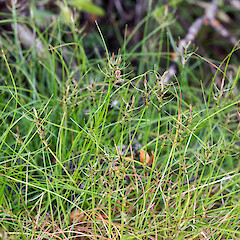Carex longifructus
Common name
bastard grass, hook sedge
Synonyms
Uncinia longifructus (Kük.) Petrie; Uncinia tenella var. longifructus Kük.
Family
Cyperaceae
Flora category
Vascular – Native
Endemic taxon
Yes
Endemic genus
No
Endemic family
No
Structural class
Sedges
NVS code
The National Vegetation Survey (NVS) Databank is a physical archive and electronic databank containing records of over 94,000 vegetation survey plots - including data from over 19,000 permanent plots. NVS maintains a standard set of species code abbreviations that correspond to standard scientific plant names from the Ngä Tipu o Aotearoa - New Zealand Plants database.
UNCLON
Chromosome number
2n = 88
Current conservation status
The conservation status of all known New Zealand vascular plant taxa at the rank of species and below were reassessed in 2017 using the New Zealand Threat Classification System (NZTCS) – more information about this can be found on the NZTCS website. This report includes a statistical summary and brief notes on changes since 2012 and replaces all previous NZTCS lists for vascular plants.
Please note, threat classifications are often suggested by authors when publications fall between NZTCS assessment periods – an interim threat classification status has not been assessed by the NZTCS panel.
- Conservation status of New Zealand indigenous vascular plants, 2017 . 2018. Peter J. de Lange, Jeremy R. Rolfe, John W. Barkla, Shannel P. Courtney, Paul D. Champion, Leon R. Perrie, Sarah M. Beadel, Kerry A. Ford, Ilse Breitwieser, Ines Schönberger, Rowan Hindmarsh-Walls, Peter B. Heenan and Kate Ladley. Department of Conservation. Source: NZTCS and licensed by DOC for reuse under the Creative Commons Attribution 4.0 International licence.
2017 | At Risk – Naturally Uncommon | Qualifiers: DP, Sp
Previous conservation statuses
2012 | At Risk – Naturally Uncommon | Qualifiers: DP, Sp
2009 | At Risk – Naturally Uncommon | Qualifiers: DP
2004 | Sparse
Distribution
Endemic. North and South Islands. In the North Island known from the Raukumara, Ruahine and Tararua Ranges. In the South Island locally known from Nelson, Marlborough, Westland, Canterbury, North Otago, said to be more common in Fiordland.
Habitat
A species of shaded slopes and peaty hollows within montane forest and subalpine scrub. Exact habitat preferences are not known.
Detailed description
Somewhat flaccid-leaved, openly caespitose, stoloniferous, rather long-spreading sedge. Stolons rather fine, < 0.5 mm diameter. Culms 30–200 × 0.5 mm, rather rigid, glabrous, basal bracts very light brown or straw coloured. Leaves 3–7 per culm, rather flaccid, equal to or < culms, slightly < 1 mm wide, involute to channelled, involute when dry, midrib distinctly thickened and paler, lamina with margins scabrid near leaf apex. Spike 10–15 × 2–4 mm, female flowers 5, close-set, internodes 1–1.5 mm long. Glumes slightly ≤ length of utricles, deciduous, lanceolate, acute, membranous to chartaceous, midrib pale green. Utricles 4.5–5.5 × 1 mm, trigonous with a prominent lateral nerve, or subtrigonous and almost smooth, elliptic-lanceolate, olive-green, spreading when ripe, stipe indistinct, scarcely narrowed, up to 1 mm long, beak tapering, 1.5 mm long.
Similar taxa
A distinctive species distinguished from other New Zealand hook sedges, by the very narrow tapered leaves, and rather short spikes with relatively long utricles. In Flora II of the New Zealand Flora Series, Carex longifructus (as Uncinia longifructis) keys out near C. drucei (Hamlin) K.A.Ford (as Uncinia drucei) from which it differs by its leaves being < 1 mm rather than > 1 mm wide, and by the olive-green rather than dark brown coloured utricles. Carex drucei prefers drier forested habitats and rock outcrops than the deep moss, mossy peat shaded habitats preferred by C. longifructus. It is also a much less spreading, more shortly stoloniferous plant than C. longifructus. Exact relationships amongst the New Zealand hook sedges have yet to be determined, and will almost certainly require a full phylogenetic analysis.
Flowering
October–December
Fruiting
October–May
Propagation technique
Unknown. Probably easily grown in a moist, peaty soil.
Threats
Believed to be a naturally uncommon, ecologically sparse species. However it is poorly known from large parts of its reported range. Further survey to ascertain its exact status is much desired.
Etymology
carex: Latin name for a species of sedge, now applied to the whole group.
longifructus: From the Latin longus ‘long’ and fructus ‘fruit’
Where To Buy
Not commercially available.
Attribution
Fact sheet prepared for NZPCN by Peter J. de Lange 17 August 2006. Description adapted from Moore and Edgar (1970).
References and further reading
Moore LB, Edgar E. 1970. Flora of New Zealand, Volume II. Indigenous Tracheophyta: Monocotyledones except Gramineae. Government Printer, Wellington, NZ. 354 p.
NZPCN Fact Sheet citation
Please cite as: de Lange, P.J. (Year at time of access): Carex longifructus Fact Sheet (content continuously updated). New Zealand Plant Conservation Network. https://www.nzpcn.org.nz/flora/species/carex-longifructus/ (Date website was queried)













